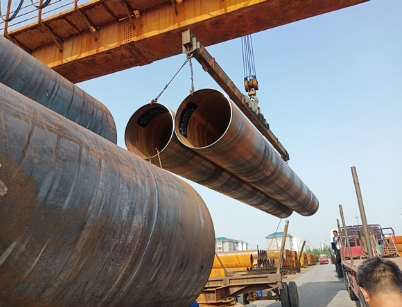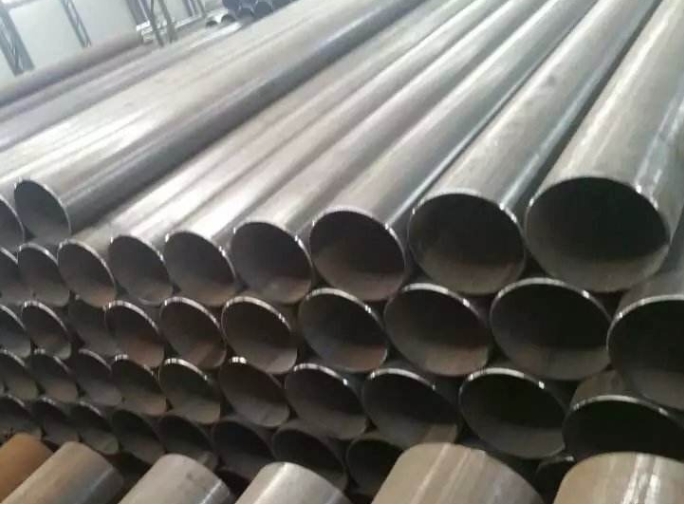Spiral steel pipes and straight seam steel pipes are both welded steel pipes. They are widely used in the transportation of liquids in various industries such as water supply, heating, oil and gas transportation, etc. They have different production processes and have different advantages in different applications. So, they What are the specific differences?
Welded steel pipe refers to a steel pipe with seams on the surface that is made by bending and deforming steel strips or steel plates into round, square, etc. shapes and then welding them. The blank used for welded steel pipes is steel plates or strips. It can be divided into straight seam welded pipe and spiral welded pipe.
Spiral steel pipe is a spiral seam steel pipe welded by automatic double-wire double-sided submerged arc welding process using strip steel coil plate as raw material, constant temperature extrusion molding. The spiral steel pipe feeds the strip into the welded pipe unit. After being rolled by multiple rollers, the strip is gradually rolled up to form a circular tube blank with an opening gap. Adjust the reduction amount of the extrusion roller to control the weld gap between 1~ 3mm, and make both ends of the welding joint flush.

The main process features of spiral steel pipe:
a. During the forming process, the steel plate deforms evenly, has small residual stress, and does not produce scratches on the surface. The processed spiral steel pipe has greater flexibility in the size range of diameter and wall thickness, especially in the production of high-grade thick-walled pipes, especially small and medium-diameter thick-walled pipes. It has advantages that other processes cannot match, and can satisfy users More requirements in terms of spiral steel pipe specifications.
b. Using the advanced double-sided submerged arc welding process, welding can be achieved at the best position, and defects such as wrong edges, welding deviations, and incomplete welding are less likely to occur, and the welding quality can be easily controlled.
c. Conduct 100% quality inspection of steel pipes so that the entire process of steel pipe production is under effective detection and monitoring, effectively ensuring product quality.
d. All equipment in the entire production line has the function of networking with the computer data collection system to realize real-time transmission of data, and the central control room monitors the technical parameters in the production process.
The strength is generally higher than that of straight seam welded pipes. Welded pipes with larger diameters can be produced from narrower billets, and welded pipes with different diameters can also be produced from billets of the same width. However, compared with straight seam pipes of the same length, the weld length is increased by 30~100%, and the production speed is lower. Therefore, smaller diameter welded pipes mostly use straight seam welding, while large diameter welded pipes mostly use spiral welding.
Spiral seam welded steel pipes are divided into two types: automatic submerged arc welded steel pipes and high-frequency welded steel pipes.
a. Spiral seam automatic submerged arc welded steel pipes are divided into two categories: Class A pipes and Class B pipes according to the pressure of the conveying medium. Category A pipes are generally welded with ordinary carbon steel Q235, Q235F and ordinary low alloy structural steel 16Mn. Category B pipes are welded with Q235, Q235F, Q195 and other steels and are used as low-pressure fluid transport pipes.
b. Spiral seam high-frequency welded steel pipes There is no unified product standard for spiral seam high-frequency welded steel pipes. They are generally made of ordinary carbon steel Q235, Q235F and other steels.
Straight seam pipe refers to a steel pipe whose weld seam is parallel to the longitudinal direction of the steel pipe. It is also generally called straight seam welded pipe or straight seam steel pipe. Straight seam pipes are made by rolling long strips of steel strips of a certain specification through high-frequency welding units and using straight seam welding. The specifications of straight-seam pipes are expressed in nominal diameter. According to the wall thickness, they can be divided into two types: thin-walled straight-seam pipes and thick-walled straight-seam pipes. According to the shape, it can be divided into round, square or special-shaped tubes. The production process is simple, the production efficiency is high, the cost is low, and the development is rapid.
Straight seam pipes are mainly used in water supply projects, petrochemical industry, chemical industry, electric power industry, agricultural irrigation, and urban construction. For liquid transportation: water supply and drainage. For gas transportation: coal gas, steam, liquefied petroleum gas. For structural purposes: piling pipes, bridges; pipes for docks, roads, building structures, etc.


